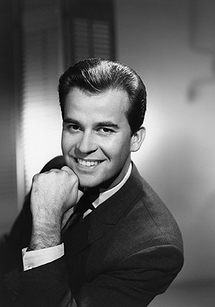به ازای هر نفری که با دعوت شما در منظوم ثبتنام میکنند 20 امتیاز میگیرید.
لینک دعوت:


After acquiring nationwide distribution the newly reformatted program, now titled "American Bandstand", premiered on ABC on August 5, 1957. In addition to the name change, Clark added interviews with artists (starting with Elvis Presley), lip-sync performances, and "Rate-a-Record," allowing teens to judge the songs on the show - and giving birth to the popular phrase, "It's got a good beat and you can dance to it." Clark also established a formal dress code, mandating dresses and skirts for the women and a coat and tie for the men. But perhaps the most impactful change that Clark made to the show was ending "American Bandstand's" all-white policy, allowing African American artists to perform on the show.
Under Clark's influence, "Bandstand" became one of the most successful and longest-running musical programs, featuring artists including Chuck Berry, the Doors, the Beach Boys, Pink Floyd, and Smokey Robinson. Sonny and Cher, The Jackson 5, Prince, and Aerosmith were among the influential artists and bands that made their television debuts on "Bandstand", which is also credited with helping to make America more accepting of rock 'n' roll.
With the success of "American Bandstand", Clark became more invested in the music publishing and recording businesses, and began managing artists, hosting live sock hops, and arranging concert tours. But in 1960, when the United States Senate began investigating "payola", the practice in which music producing companies paid broadcasting companies to favor their products, Clark became caught up in the scandal. The investigation found he had partial copyrights to over 150 songs, many of which were featured on his show. Clark denied he was involved in any way, but admitted to accepting a fur and jewelry from a record company president. In the end, the Senate could not find any illegal actions by Clark, but ABC asked Clark to either sell his shares in these companies or leave the network so there was no conflict of interest. He chose to sell and continue on as host of "American Bandstand", which was unaffected by the scandal.
In 1964, Clark moved Bandstand from Philadelphia to Los Angeles and became more involved in television production. Under his company Dick Clark Productions, he produced such shows as "Where the Action Is", "TV's Bloopers and Practical Jokes", and more recently, "So You Think You Can Dance", as well as made-for-television movies including "Elvis", "The Birth of the Beatles", "Wild Streets", and "The Savage Seven". Clark also hosted television's "$10,000 Pyramid", "TV Bloopers and Practical Jokes" (with co-host Ed McMahon), "Scattergories", and "The Other Half". Clark also had several radio programs, including "The Dick Clark National Music Survey", "Countdown America", and "Rock, Roll & Remember".
In 1972, he produced and hosted the very first edition of "Dick Clark's New Year's Rockin' Eve", a musical program where Clark counted down until the New Year ball dropped in Times Square, featuring taped performances from musical artists. "New Year's Rockin' Eve" soon became a cultural tradition, airing on ABC every year with Clark as host (except in 1999 when ABC aired "ABC 2000: Today", a news milestone program hosted by Peter Jennings). In December 2004, Clark suffered a minor stroke and was unable to host, so Regis Philbin stepped in as a substitute. The following year, Clark returned as co-host alongside primary host Ryan Seacrest. Many were worried about Clark due to his slurred and breathless speech, and he admitted on-air he was still recovering but that he wouldn't have missed the broadcast for the world. The following year, Seacrest became "New Year's Rockin' Eve's" primary host, but Clark always returned for the countdown.
Clark has received several notable awards including four Emmy Awards, the Daytime Emmy Lifetime Achievement Award in 1994, and the Peabody Award in 1999. He was inducted into the Hollywood Walk of Fame in 1976, The Radio Hall of Fame in 1990, Broadcasting Magazine Hall of Fame, the Rock and Roll Hall of Fame, and the Academy of Television Arts & Sciences Hall of Fame. Clark had been in St. John's hospital in Los Angeles after undergoing an outpatient procedure the night of April 17, 2012. Clark suffered a massive heart attack following the procedure. Attempts to resuscitate him were unsuccessful and he died the next morning of April 18, 2012.